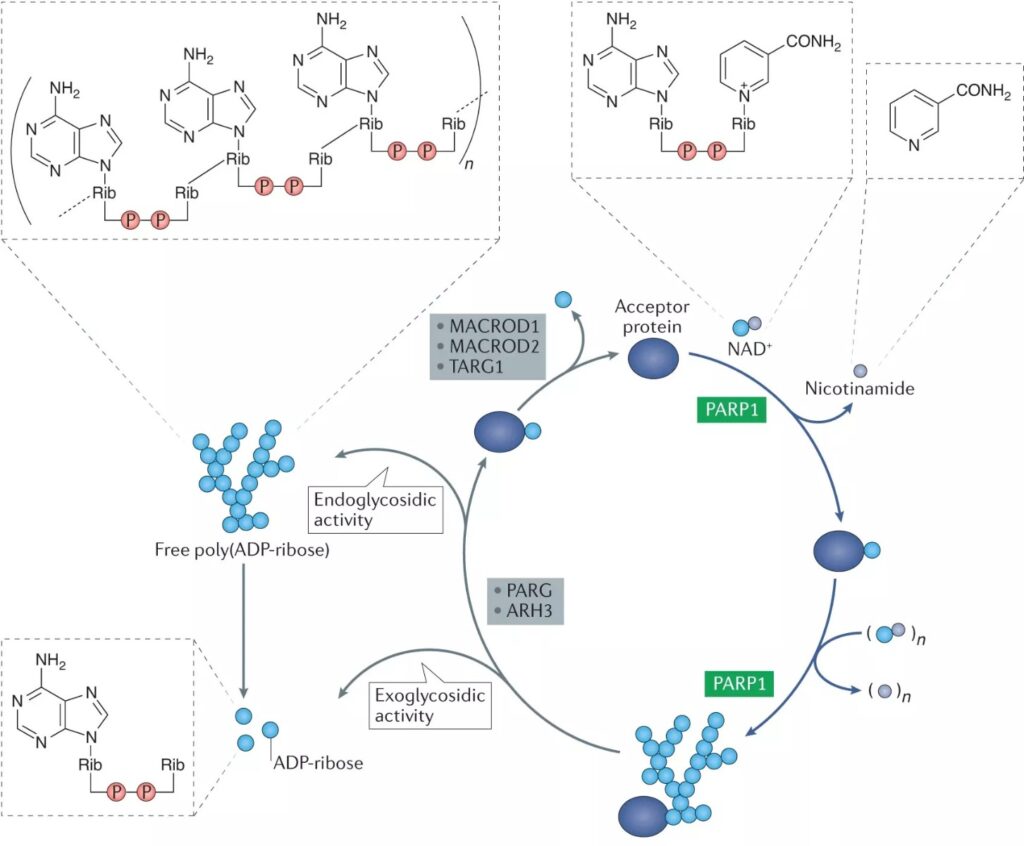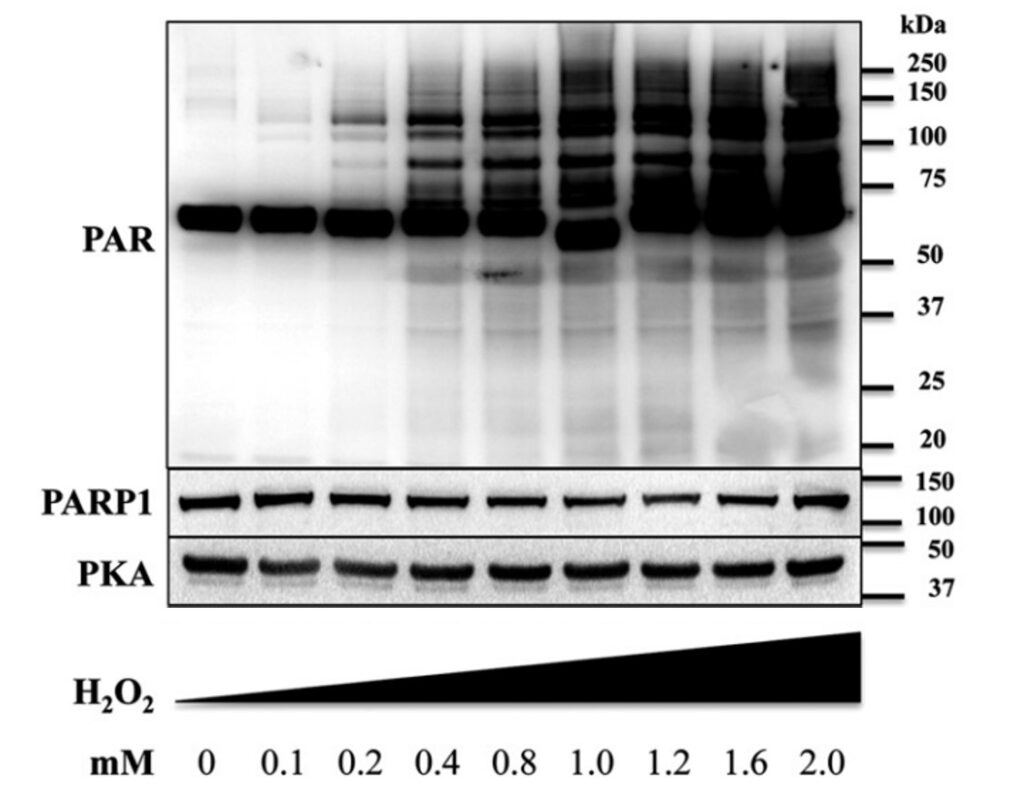
Poly(ADP-ribosyl)ation, also known as PARylation, is the post-translational modification process (similar to modifications like phosphorylation, methylation or acetylation) by which polymers of (ADP)-ribose (pADPr or PAR ranging from 2 to more than 200 ADP-ribosyl residues) are covalently attached to nuclear proteins by PAR polymerase (PARP) enzymes. The post-translational modification poly(ADP-ribosyl)ation (PARylation) plays key roles in cellular physiology and stress response. The modification is catalysed by members of the family of poly(ADP-ribose) polymerases (PARPs, also known as ARTDs). It is involved in cellular functions including genome maintenance, DNA damage response, DNA repair, replication, transcription, chromatin remodelling, stress response, metabolism and regulation of cell death. In addition, PARPs represent promising targets in cancer therapy, either as chemosensitisers in combination with classical DNA-damaging chemotherapeutics or as stand-alone drugs for tumours deficient in homologous recombination.
Poly(ADP-ribose) Polymerases (PARPs)
The posttranslational modification of nuclear proteins with poly(ADP)-ribose (PAR) is catalysed for the most part by enzyme poly(ADP-ribose) polymerase 1 (PARP-1/ARTD1), and to a lesser extent by several additional poly(ADP-ribose) polymerases, by using NAD+ as substrate. PARP-1 is an abundant, highly conserved and constitutively expressed protein. Its catalytic activity, however, depends mainly on the presence of DNA single or double-strand breaks, which are recognised by the two zinc fingers of the DNA-binding domain of the enzyme.
PARP-1 is selectively activated by DNA strand breaks to catalyse the addition of long-branched chains of PAR to a variety of nuclear proteins, most notably PARP itself. The amount of PAR formed in living cells with DNA damage is commensurate with the extent of the damage. Under DNA damage conditions, PAR undergoes a rapid turnover, with a half-life in the range of minutes, as PAR is rapidly hydrolysed and converted to free ADP-ribose by the enzyme poly(ADP-ribose)glycohydrolase (PARG).
Apart from auto-modified PARP-1, a number of proteins have been identified as target proteins (“acceptors”) for poly(ADP-ribosyl)ation, including the chromatin-architectural protein DEK. Importantly, PAR has been shown to bind with a variety of proteins in a non-covalent yet specific manner. The affinity of such non-covalent PAR interactions with specific binding proteins (i.e. XPA, p53, WRN) can be very high (nM range) and depends both on the PAR chain length and on the binding protein, which suggests the existence of a “PAR code”.
As indicated above, PAR regulates not only cell survival and cell-death programs but also an increasing number of other biological functions with which novel members of the PARP family have been associated. These include transcriptional regulation, cell division, intracellular trafficking, inflammation and energy metabolism.
Literature References:
- Functions of PARylation in DNA Damage Repair Pathways: H. Wei & X. Yu; Gen. Prot. Bioinform. 14, 131 (2016)
- In Vivo Level of Poly(ADP-ribose): M. Miwa, et al.; Challenges 9, 23 (2018)
- The Enigmatic Function of PARP1: From PARylation Activity to PAR Readers: T. Kamaletdinova, et al.; Cells 8, 1625 (2019)
- Novel insights into PARPs in gene expression: regulation of RNA metabolism: Y. Ke, et al.; Cell. Mol. Life Sci. 76, 3283 (2019)
- Poly(ADP-Ribose) Glycohydrolase (PARG) vs. Poly(ADP-Ribose) Polymerase (PARP) – Function in Genome Maintenance and Relevance of Inhibitors for Anti-cancer Therapy: D. Harrision, et al.; Front. Mol. Biosci. 7, 191 (2020)
- Poly(ADP- ribose) polymerase inhibition: past, present and future: N.J. Curtin & C. Szabo; Nat. Rev. Drug Discov. 19, 711 (2020)
High Quality Reagents for PAR & PARP Research
The STANDARD anti-Poly(ADP-ribose) [PAR], mAb (10H)
A large part of the recent progress in the PARP field, especially as it relates to the catalytic activity of the enzymes, can be attributed to the development of novel ADP-ribose-detecting reagents. For decades, the field relies on the anti-PAR monoclonal antibody clone 10H (Prod. No. AG-20T-0001), which binds to PAR chains >10 ADP-ribose units in length and which even allows to visualise Poly(ADP-ribose) (PAR) formation at the level of intact cells by immunofluorescence. This anti-PAR (10H) antibody is therefore considered a standard antibody in the field of PARylation and has been published in hundreds of publications. This antibody has been used in Western blot, immunohistochemistry, immunocytochemistry and flow cytometry studies. The monoclonal antibody 10H recognises poly(ADP-ribose) synthesised by a broad range of PARPs (poly(ADP-ribose) polymerases), including human, mouse, rat or Drosophila PARP enzymes.

Highly Active PARPs & PARG
Specific PARP Antibodies
Small Molceule Modulators of PARPs & PARG
Originally posted on adipogen.com/parylation-parp
Caltag Medsystems is the distributor of Adipogen products in the UK and Ireland. If you have any questions about these products, please contact us.
